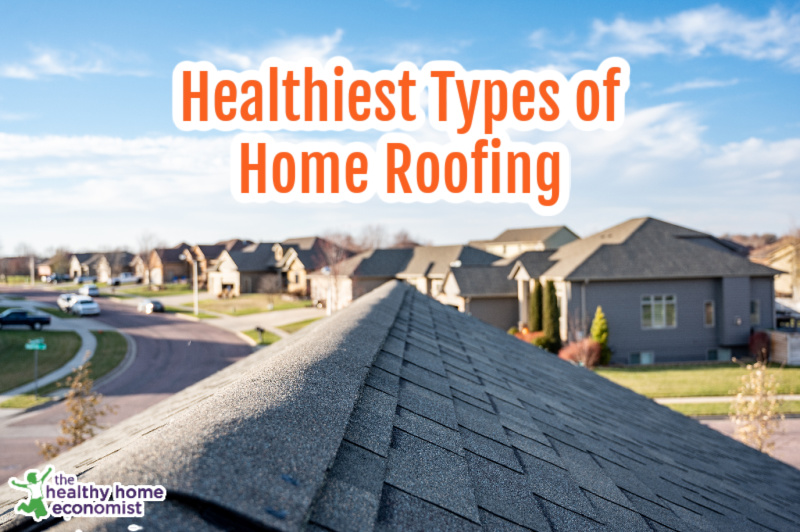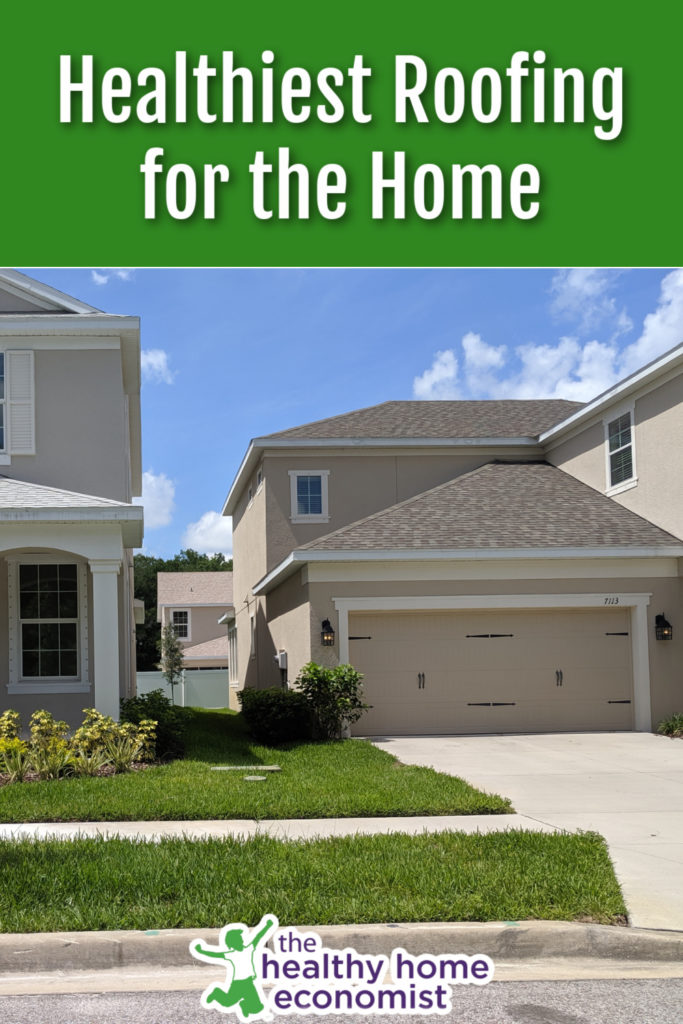Analysis of the five different types of roofing materials and which is healthiest for those living in the house below.

When building a new home or buying an existing one, roofing style is probably the last thing you would ever consider as having an impact on health.
I’ve written before about how solar panels on the roof of a home are unhealthy, but what about the actual material of the roof itself?
Can this have an impact on health too?
Surprisingly, yes it does!
Types of Roofing Materials
Before I go into the health benefits of some types of roofing materials over others, let’s overview the five most common types.
Asphalt Shingles
The most popular type of roof, asphalt shingles are affordable and suit most architectural styles.
They are also are easy to install and work well in a variety of climates.
Clay and Concrete Tile
Common in my home state of Florida, clay and concrete tile roofs work well for Mediterranean and Spanish-style homes.
This style of roof is usually chosen because of its 50-year durability and curb appeal.
Slate
Like tile, slate roofs are long lasting for many decades. They also offer fire-resistance and can be recycled.
However, they tend to not be as popular due to the need for professional installation and cost.
Wood
Wood roofing is typically made from redwood, southern pine, and cedar. It is most suited to dry climates that don’t see much rain or fires. Few places on the planet would qualify with these characteristics.
Wood is also very expensive as a roofing material, which combined with its impracticality, makes it a fairly unpopular choice.
Metal
Metal roofs made of aluminum, copper and/or steel are catching on in recent years. They have come a long way since the cheap versions installed on the old barns of yesteryear.
Metal roofing for homes is available as shingles or panels. Copper and stainless versions offer durability that rivals and even exceeds tile and slate. This combined with the affordability of premium asphalt shingles is causing metal as a roofing option to really take off.
In addition, metal is very low maintenance and environmentally friendly. More on this below.
While this style looks best on cabins or bungalows, metal roofing can be manufactured to look like slate or asphalt to suit other architectural styles.
Which Home Roofs are Healthiest?
The roof of our home is made of asphalt shingles that were installed in 1997. They were designed to last about 25 years, so they are definitely coming to the end of their usable life.
A lot of things have changed environmentally since then.
Blocking EMFs
The biggest is the advent of widespread EMFs with 5G from towers starting to roll out. Space-based 5G from satellites is coming soon as well. (1)
Hence, when we replace our roof, we will be installing metal panels or shingles, as this is the most effective roofing material for blocking unwanted EMFs. (2)
The downside is that any EMFs generated inside the home will be reflected by the metal roof as well, hence mitigation of home EMFs is important too.
However, EMFs from outside the home are, by and large, much stronger and potentially health disrupting than those that are inside. Examples include Wifi which is within your control to reduce or even eliminate. Thus, the benefits of a metal roof for protection from unwanted outside EMFs cannot be overstated.
Of course, the elimination of 5G exposure in the home doesn’t just involve the choice of roof. There are other important strategies to implement as discussed in the linked article.
If you are not sure of the current EMF load in your home, I recommend this inexpensive device as something to consider for regular measurement.
No Offgassing
Another health advantage of metal roofs is that they are recyclable and do not off-gas toxins into the home. (3)
Tile and slate roofs also offer limited EMF protection and do not leak toxins, but are a more expensive option.
Asphalt shingles are the least protective and should be avoided especially if you live in a high EMF, urban area. They also have the potential to off-gas toxic fumes into the home. This can occur during high heat times of the year when the roof’s surface temperature can reach 140-190 F/ 60-88 C. (4)
Since we live in Central Florida and our asphalt shingle roof faces west during the hottest part of the day, we’re combatting this problem for the time being (until we need to get a new roof) with HEPA air filters (one for every 500 square feet or so) to remove airborne toxins that leak into the house.
Replacing Your Roof Soon?
Since roofing style is one of the most expensive maintenance issues for a home, if replacement is in your future, I would suggest investigating metal as the healthiest choice for our increasingly hyper-connected world. It is also a green choice that is affordable with no off-gassing concerns even in hot climates.

(1) 5G from Space
(2) Do Metal Roofs Attract or Block EMFs?
(3) Healthy Home Roofing
(4) Are Asphalt Shingles Toxic?








I was told by a friend whose husband is a fire inspection engineer to never have a metal roof bc if there were a fire in your home it would burn to the ground faster bc the metal would trap the flames inside. But this info about the asphalt gasses and EMFs has me wondering if metal would be better.
Would a metal roof protect against the emf from solar panels on top of that roof?
Partially … but the EMFs would also surround the home and enter via windows and walls. Any activity around the home outside would be a high EMF field as well, so children playing basketball on the driveway, for example, would be subjected to the effects too.
You caught my attention when you stated that metal roofing is one of the most environmentally friendly roofing materials out there. Being conscious of the environment in everything I do is something I try to keep up as much as possible. Now that I need to do some renovations for my house, I’ll make sure I opt for metal roofing for this job.
If we are stuck with Asphalt, will the toxins be off gassed enough to not be a concern after several years? I really do want a metal roof. Tile and slate aren’t common on the East coast,however
Yes, they keep offgassing as I mentioned in the post about our asphalt roof.
Great article! People need to be more informed on this since more and more “signal” is in the air! We have a metal pole barn style house and I am so happy we decided many years ago to go that way. I recently bought a tester and as long as cell phone abd wifi is off, we have zero signal inside! A family member has metal roof and siding but she had tons of signal coming straight through front windows on her house…SO…she added metal screens and that fixed the problem! So thankful for metal siding and roofs right now!
Hi Sarah,
I have a metal roof made by Decra and I really like it. My only concern with toxicity is the underlayment. You made no comment to that. We had a peel and stick to prevent all water leaks as we live here in Florida too, with lots of rain. It is a black thick layer of what looks like vinyl that is sticky on one side and applied over the plywood before putting on the metal. I am thinking that the underlayment that is needed under the metal roof is probably toxic. Especially in our high temperatures. Possibly the tar paper type would be less toxic, although possibly less efficient? Do you have any info on this? I also use air filters because even the plywood on the roof is very toxic in high heat.
Most underlayments are made from bitumen or asphalt or tar, or adjacent materials. Some are rubber, some are polypropylene. You are so right that this also needs to be addressed. I got to this site because I’m trying to find ecological and non-toxic alternatives to the membrane layer that is meant to go under the roofing material, and it’s really hard to find anyone even talking about this. Looks like I have to keep searching. Oh well.